According to Henry Ford, “Failure is the opportunity to begin again, only more intelligently.” Never has this statement been more pertinent to the trucking industry than in 2008, with reports of nearly 2,000 trucking company bankruptcies during the first half of the year. While this includes many smaller carriers whose balance sheets were not strong enough to survive the current market turmoil, the larger players in the industry have been hit just as hard by unprecedented diesel fuel prices and the overall state of the U.S. economy.
The American Trucking Association (ATA) estimates that trucks haul 70% of all freight tonnage and that 80% of all U.S. communities receive their goods exclusively by truck, which means that distress in the trucking industry has the potential to increase the cost of nearly all products consumed by Americans. This fundamental reliance of our economy on the transportation sector means that opportunities abound for trucking company stakeholders to take charge of their organizations by developing roadmaps for success. These roadmaps can help carriers to not only survive but even thrive during difficult times.
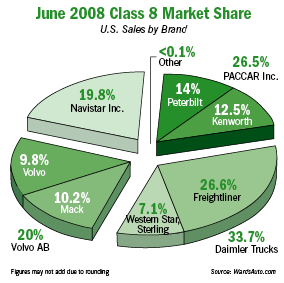
At the $4.00 per gallon mark, it costs more than $1,000 to fill up most 18-wheelers. While diesel costs vary by region, the U.S. national average cost of diesel increased 64% during the 12-month period ended June 30, 2008. Although diesel prices have since retreated, they remain well above 2007 levels. The ATA estimates that every one penny increase in the price of diesel costs the industry an additional $391 million per year. For many motor carriers, fuel has surpassed labor as their single largest operating expense.
The spike in crude oil prices this past summer to nearly $150 per barrel was a harsh reminder that high energy costs are likely to impact the industry for the foreseeable future. Diesel prices may be down from their summer highs, but they still remain well above historical levels. In addition, the U.S. Environmental Protection Agency has mandated new emissions standards, which are being phased in from 2007-2010, and involve more expensive “clean-diesel” engines and ultra-low sulfur diesel. The challenges presented by these market and regulatory forces are undeniable, but the question of how to deal with these challenges remains.
While there are many segments to the trucking industry (private commercial fleets, for-hire carriers, truckload, less-than-truckload, regional, long-haul, etc.) and varying business models, there are fundamental financial management and operating strategies common to all that should be employed to help maximize operating efficiency and profitability. Let’s take a look at some of these best practices.
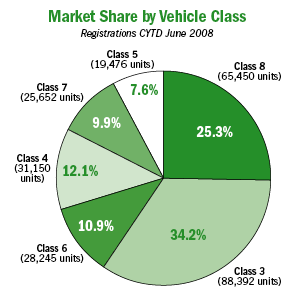
It’s difficult to pinpoint operating inefficiencies if the proper daily, weekly and monthly operating statistics are not being accurately measured and trended. For example, how many carriers measure the time drivers spend waiting for freight to be loaded or unloaded?
The emphasis must be on measuring things like operating ratios, line-haul revenue per mile, miles-per-gallon, fuel recapture rates, maintenance cost per mile (scheduled & unscheduled), tire cost per mile, fleet miles per week, fuel cost-per-gallon, deadhead or empty miles, out-of-route miles, engine idle times, safety-related measures (accident rates), driver turnover rates, fleet age and equipment utilization rates. Weekly management meetings to review all key operating metrics are also vital to ensure that the data is properly interpreted and processed to address problem areas.
Identify Unprofitable Routes & Customers
Like all other service businesses, being a good operator is predicated on a detailed understanding of all fixed and variable costs. Once these costs are properly accounted for, a pricing model that recognizes break-even points can be systematically implemented with the customer base. Each truck is essentially its own profit or loss center, although any profitability analysis should always recognize that a truck may have unprofitable routes or segments within an overall customer tour that is profitable.
While the emphasis should always be on repricing and retaining business, an exit strategy may make more sense if the carrier has incompatible business segments. For example, having an inefficient mix of short-haul and long-haul work can wreak havoc on scheduling and utilization rates. Route profitability can also be attacked from the cost side. Replacing leased or owned units with third-party carriers such as independent owner-operators can reduce debt service, labor costs and other overhead associated with fleet ownership. Intermodal transport, which incorporates rail and/or boat service, can be another cost-effective option for shipping freight that can be moved more slowly.
Seek the Surcharge
In many ways, hauling freight is a relatively simple service business based on understanding costs and getting paid accordingly. While permanent pricing increases may be more beneficial in the long run, they are not always a good substitute for fuel surcharges. This is particularly true in an environment of rapidly rising fuel prices, which may outpace a fixed-rate increase. Surcharges can be structured many ways, but it’s important to negotiate the lowest possible trigger point and identify a benchmark that best matches the carrier’s circumstance (e.g., regional versus national fuel price averages).
For those customers that push back on fuel surcharges, their pricing can be addressed in other ways. Increasing line-haul rates and rates for other logistics services, eliminating payment discounts and consolidating fuel suppliers to generate fuel rebates can all lessen the impact of customer resistance on surcharges.
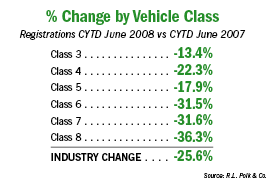
Mobile satellite communication systems are a vital part of generating real-time data for things like load scale, load assignments, arrivals and departures, routing information, fueling, and more. These systems can be easily customized to match the scale and complexity of the logistics operation, and they connect to the user’s host computer to interface with application and operations software such as dispatch, accounting and payroll.
These systems are designed to offer not just messaging services but extensive data management capabilities like fleet grouping by region, unit availability, unit routing, driver hours of service tracking, trailer yard checks, pallet counts and on-road breakdown communication. Trailer management systems have evolved to the point where they can provide real-time information on electronic braking, suspension control, cooling systems, tire pressure and more.
Reduce Deadhead and Out-of-Route Miles
While it cannot be avoided completely, driving empty miles is usually the single costliest problem for any trucking company. Empty or “deadhead” miles refers to a situation where a truck delivers a load from point A to point B and then returns empty or proceeds to point C empty to pick up its next load. These empty segments are often referred to as “backhaul” or “gap” lanes. The key to dealing with gap lanes is to first fill them with any loads to generate revenue, even unprofitable broker loads subject to commissions. Once the gaps are filled, the next steps are to replace the broker loads with customer loads, intensify customer service efforts and push for rate increases on those lanes.
Out-of-route miles include any other non-manifest miles and are just as damaging to profitability. Some drivers are permitted to take their trucks home on weekends. While this type of perk may be useful in attracting and retaining quality drivers, setting reasonable limits on these mileage allowances is essential. Miles driven to terminals and maintenance facilities can also be out-of-route if not strategically located within proximity of customer routes.
Minimize Engine Idling
Engine idling burns roughly one gallon of diesel per hour, while utilizing on-board auxiliary power units (APUs) to cool or heat the cabs during rest stops burns only one-fifth that amount of diesel. Many owners have historically resisted this capital expenditure because of the up-front cost involved (APUs can cost upwards of $10,000 each), but the payback on these units can often be realized in as little as 12 months.
Having the APU is one thing, but enforcing driver compliance is another issue. Many drivers needlessly idle their engines during rest stops, and this is where onboard communication systems can be particularly effective. The hardware and software options on these systems are capable of monitoring engine idling time to provide real-time feedback on which drivers are not powering down.
Even governmental regulators are now looking more closely at the issue of engine idling, and Florida’s Environmental Regulation Commission recently approved a rule barring heavy-duty trucks from idling longer than five minutes. This regulation will take effect December 15, 2008 and carries a $1,000 fine for noncompliance, although there will be exceptions made for idling during vehicle inspections, safety emergencies and other necessary functions.
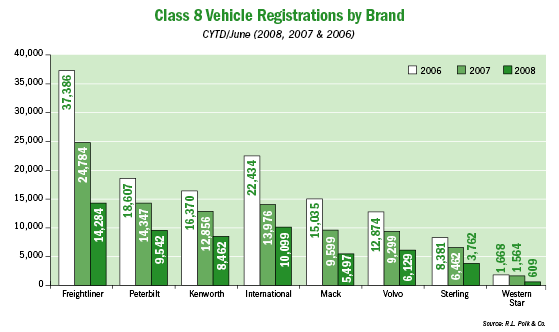
In simple terms, the faster a truck travels the less fuel efficient it becomes. Wisconsin-based Schneider National, the nation’s largest privately held trucking company, took measures earlier this year to decrease its maximum speed for its fleet of over 10,000 tractors to 60 miles per hour. Wal-Mart’s fleet, which ranks number two on the Transport Topics 100 list of the largest U.S. private carriers, covers 900 million miles a year. Its volume is so enormous that a one mile per gallon improvement in fuel efficiency saves tens of millions of dollars a year.
Getting drivers to voluntarily comply with reduced speed requirements can be challenging, so the use of electronic regulators to cap speed is a simple and efficient way to ensure these speed limits are being realized. It’s estimated that for each mile per hour below 65 miles per hour, a truck can save up to 1.5% in fuel consumption. Assuming an average fuel efficiency of six miles per gallon and diesel cost of $4.00 per gallon, a single truck running 2,500 miles per week could realistically save $5,000 per year in fuel costs by reducing speeds from 65 to 60 mph. For a carrier with 1,000 power units, this would equate to an annual cost savings of $5 million.
Implement Tire Strategies
After labor and fuel costs, tire maintenance and replacement represents the third-largest expense for most carriers. Proper tire inflation is the key element to maximizing fuel efficiency. Automatic tire inflation (ATI) systems can be particularly helpful in this area, and the SmartWay Transport Partnership of the U.S. Environmental Protection Agency estimates that an ATI system on a typical line-haul truck can generally pay for itself in just over two years as well as decrease the risk of costly tire failures caused by under-inflation.
An under-inflated tire is prone to wear and tear on its shoulders, potentially leading to “zipper ruptures” along its sidewall. Likewise, an over-inflated tire’s shoulders will lift off the ground, resulting in increased wear on the middle portion of the tread. A deviation of 10 psi from specification is estimated to increase tire wear by 7%-15%. Given the importance of tire inflation, air pressure gauges should be tested regularly at a master calibration station.
Tire tread is another important factor in determining cost-per-mile. “Deep lug” tires have deeper treads, provide greater traction for adverse conditions and last longer, but they are less fuel efficient. For trucks not constantly exposed to heavy snow and mud conditions, “rib” tires with lighter treads provide more than adequate traction for the vast majority of road applications. Although they wear out sooner, they are estimated to help improve mileage by about 2% for every gallon of diesel burned. In addition, paying more for premium tires is a worthwhile investment because of the longer lifespan associated with higher-quality casings.
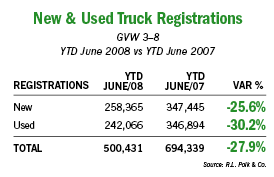
Many things can be done to maximize the performance of trucks and trailers. With respect to the power units, things like aluminum alloy wheels, axle hubs, clutch housings and cab frames can all help to reduce hundreds of pounds of weight from the tractors. Likewise, thousands of pounds of weight can be removed from trailers by using aluminum roof posts, floor joists, upright posts, hubs and wheels.
Tractor aerodynamics can be improved by adding cab extenders, air dams and integrated roof and side fairings. Trailer aerodynamics can be enhanced by minimizing tractor-trailer gap and by adding side skirts and rear air dams. On the maintenance side, low-viscosity synthetic or semi-synthetic lubricants flow more easily and help reduce the wear and tear on engine, transmission and drive train systems. The ATA’s Technology & Maintenance Council publishes a Recommended Practices Manual, which has been recognized for more than 30 years as a leading maintenance guide covering many technical aspects of maintenance, equipment and supporting technologies.
Maximize Driver Performance
Hiring qualified drivers and minimizing driver turnover plays an important role in managing costs. Excessive driver turnover, which typically exceeds 100% for the truck-load segment of the industry, can cost companies thousands of dollars per driver in recruiting, training, separation and opportunity costs. That’s why it’s important to have a formal screening process and competitive pay scale that will attract seasoned drivers who understand the mechanics of big trucks and know how to drive in ways to maximize fuel efficiency.
Driver training programs should emphasize techniques such as progressive shifting, engine speed optimization, idle reduction, smoother acceleration and braking, anticipatory driving and optimal gearing. Driver incentive programs should be tied to productivity and profitability and measured against things like miles driven, fuel efficiency, on-time delivery and safety records. Even driving ability can now be monitored with onboard technology that captures truck movement data such as hard braking, sudden lane changes and high-speed turns.
Go the Distance
Given the many challenges facing the trucking industry these days, carriers need to pay attention to every detail of their operations. A survey of North American private commercial fleets conducted by Transport Topics in 2007 revealed that a staggering 35% of all respondents failed to utilize any type of dispatch and routing software as part of their business. In addition, managing overhead in the trucking world is a perpetual endeavor, which requires focus, determination and creativity. Whether it’s outsourcing non-core administrative functions or shedding unnecessary terminal costs, it’s important to review every dollar spent at least monthly.
Truckers also need to take advantage of all available resources to avoid getting blindsided. The ATA recently launched ATA Business Solutions, a line of informational products, business tools, services, training programs and conferences designed to address critical issues affecting the industry. There are many other useful resources like TruckersB2B, a business-to-business membership program designed to create volume buying power for small- and medium-sized trucking companies. Members receive discounts on things like equipment, fuel, tires, maintenance, insurance and office supplies.
Being successful in today’s trucking market is no simple task, but it is achievable with a strategic business plan focused on operations, customer pricing, fuel, maintenance and overhead. Those who travel down the road to success do more than just pay attention to the signs; they always stop to pay their toll. In the immortal words of Benjamin Franklin, “Drive thy business or it will drive thee.”

No tags available